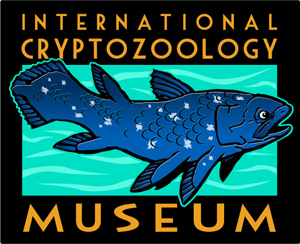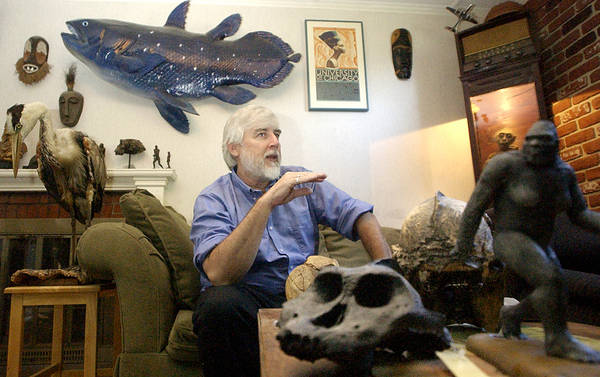Cryptozoology
 I've just learned that THE International Cryptozoology Museum will be opening a permanent exhibit space just two blocks away from my apartment in downtown Portland, Maine.
I've just learned that THE International Cryptozoology Museum will be opening a permanent exhibit space just two blocks away from my apartment in downtown Portland, Maine.(logo courtesy of Loren Coleman, www.cryptomundo.com)
Local cryptozoologist Loren Coleman has an impressive collection that includes life-sized Bigfoot replicas, lake monster models, and a Coelacanth, among many other curiosities. These objects had been crowding his living room (BoingBoing wrote about a visit to his home two years ago), where he'd offered private tours of the collection by appointment. The new museum space on Congress Street, in the middle of the city, will give his exhibits a more prominent, public display.
Coleman, the museum's founder, also blogs about cryptozoology at the website www.cryptomundo.com. A blog post announcing the new museum was published two weeks ago:
The mission of the museum is to share the many items I have collected during the last half a century, with tourists, teachers, researchers, scholars, colleagues, students, documentary filmmakers, news people and the general public...The museum is also looking for donors: "For any patron who wishes to send in a donation of $1000 (one thousand dollars) or more, I shall be sending to you ~ anywhere in the world ~ a first generation copy of an Orang Pendek footcast," writes Coleman. If you're interested, follow this link.
[the collection includes] hundreds of cryptids toys and souvenirs from around the world, one-of-a-kind artifacts, a life-size 8 feet tall Bigfoot representation, a full-scale six-foot-long coelacanth model, over a hundred Bigfoot-Yeti-Yowie footcasts, jackalopes, furred trout, along with such Hollywood cryptid-related props as The Mothman Prophecies’ Point Pleasant “police” outfit, the movie P. T. Barnum’s authentic 3.5 feet tall Feejee Mermaid, the TV series Freakylinks‘ 11 ft long “Mystery Civil War Pterodactyl,” and some of the movie Magnolia’s falling frogs.
 Coleman at his home, which he had been sharing with the museum's collections. Photo by Amber Waterman of the Lewiston Sun-Journal.
Coleman at his home, which he had been sharing with the museum's collections. Photo by Amber Waterman of the Lewiston Sun-Journal.Coleman seems aware that his field is substantially influenced by pop-culture silliness, and to his credit he seems OK with that.
But cryptozoology is really interested in making new zoological discoveries, and there's still plenty we don't know about the world's biological diversity. A recent post on Coleman's blog heralds the official scientific description of a new deepwater species of ghostshark, and the museum's logo (above) features a Coelacanth, a species known only from prehistoric fossils, and believed to be extinct, until fishermen caught a live specimen off the South African coast.
If modern science can discover a living fossil, who's to say it won't someday discover the real Abominable Snowman?




2 comments:
The problem with cryptozoology is that proponents are constantly giving undue credit to anomalies and then they jump to conclusions. Every time a half-decomposed hairless small mammal is found, they immediately call it chupacabras, only to have it later identified as something rather common by actual zoologists who systematically and scientifically figure out exactly what it is.
Actually, Scott, you've gotten your facts all turned upside down here.
Folks in the media, uninformed members of the general public, and rare fakers are the ones who rush forth with quick statements about something found or shown as being a "monster," "phantom creature," or even, to use your example, a "Chupacabras."
Nine times out of ten, it is the open-minded but skeptical cryptozoologists, like myself, who are interviewed and within moments of the find are labeling the carcass as a "canid with mange," "bloated hairless raccoon," "dead dog along the road," "domestic cat," "escaped monkey," or "store-bought gorilla costume."
Double-check and you will see this has been the case.
Cryptozoology, technically, collects a wide variety of ethnoknown sightings and reports that may produce leads to the discovery of new species. Sometimes bumps in the road do get thrown in our paths, but self-screening is the routine practice, not the exception to the rule. However, these overblown, media-loved, melodrama incidents are what is mostly incorrectly tied to "cryptozoology," when, in fact, they are the least important part of the study of hidden animals.
I look forth to visitors to the museum, from skeptics such as Scott, to my apparent neighbor, the owner of this blog. Thank for for your highlighting this new opening on November 1st.
Enjoy the Quest!
Loren
Post a Comment